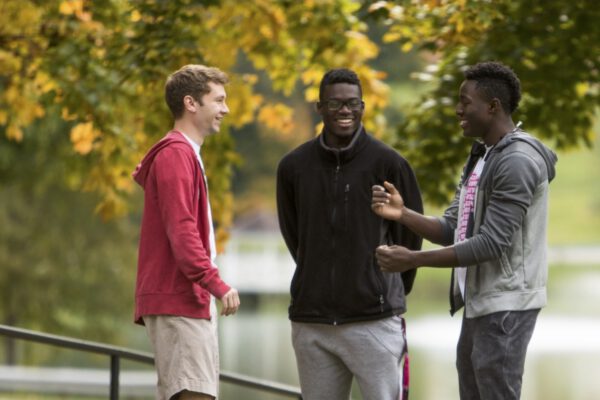In March 2019, ACE held a plenary session at its 101st Annual Meeting called “Talking About Race.” Continuing the discussion started by the panel, the Let’s Talk About Race interview series captures the voices of prominent higher education scholars and leaders as they share their perspectives and experiences on race and ethnicity in higher education. This work is part of ACE’s Race and Ethnicity in Higher Education: A Status Report project, which is sponsored by the Bill & Melinda Gates Foundation.
Q: In general, what do you feel is the role of higher education in breaking down barriers across race?
Education, and especially public higher education, is about nation building. The foundational values of our nation call for equality of opportunity and civic vitality, which are unattainable without the efficacy that education bestows. Therefore, our commitment to education is a commitment to American values.
Our democracy promises and requires social mobility to sustain itself. Otherwise, people stop believing in the American dream. Higher education has been, and must continue to be, the driver of economic growth, prosperity, and democratic values. It’s an essential role that we would be remiss in neglecting; if we do not invest in education, we’re not investing in America.
For higher education institutions to fulfill our responsibility to break down barriers across race, we will need a concerted, intentional, thoughtful approach to the issues of inequality, racial disparity, and achievement gaps. These are national, moral imperatives with practical consequences.
Q: Given your life experiences and your professional preparation, how did you obtain a knowledge base in equity, diversity, inclusion, and social justice in higher education?

My knowledge base is a product of both personal history and my professional experience. I’m a first-generation college graduate. I’m a son of an immigrant. My father, a man with a big heart and a deep commitment to social justice, only had a third-grade education. I think that tradition of progressive thinking in my family, part of Cuban political culture as well, sensitized me and led me down this path of looking at education as the ladder for personal and professional attainment.
I’ve been fortunate to serve institutions whose commitment to diversity, access, affordability, and student success has been real—it has come from the top and has been in the DNA of the institutions. At Florida International University, as former head of the Ethical Culture Fieldston School, and now as chancellor of Penn State Abington, I’ve served institutions with deep progressive roots and clear, unyielding commitment to narrowing the achievement gap and empowering students of all walks of life for success.
I’ve been fortunate to be part of networks of likeminded individuals who share a passion for education as the engine for democratic vitality.
Q: If you were going to educate students differently today, so they evolve into more critically conscious, equity-minded citizens, how would you do it if money weren’t a factor?
I am a progressive educator. I believe that experiential learning and place-based education in a community of diversity produces better outcomes for students and enhances their learning possibilities. Therefore, if funding were not a factor, I would expand opportunities for diverse groups of students to travel and learn outside of the classroom in other cities, rural areas, and overseas. We would engage in project-based learning and ask fundamental questions. We would have a very engaged, hands-on education that marries theory with practice.
We are trying to change mindsets. Only through internalization of experiences do we really reshape our values and bridge differences. Helping students evolve into more critically conscious, equity-minded citizens requires an approach that is very experiential, high-impact, and engaged with the real world, but always informed by theory.
Q: Considering both your academic background and your experience in higher education, what kinds of training, formal or informal, would you recommend for faculty who may say, “These issues aren’t a part of my discipline,” or “Atoms don’t see race”?
This is a fascinating question because sometimes faculty stop learning. Campuses that thrive have a robust culture of learning among their faculty. I would recommend critical race studies [and] culturally relevant pedagogical practices, all research-based and data-sensitive. To convince our faculty colleagues, we must show that better student outcomes are achievable.
Faculty will support processes and solutions that they themselves generate. I see this learning community as faculty led—both insiders and outsiders coming together to look at best practices and have open conversations around what produces better results for students across racial and gender divides.
For instance, we see that in gateway courses in math and science, the gender and racial divides are clear. At Penn State Abington, the faculty created a STEM gateway course task force, and put in place recommendations to teach in different ways to improve the success rate of students. That task force was informed by practices elsewhere—by data, by thoughtful conversations—but ignited and illuminated by this notion that students can learn, and sometimes we need to teach, in different ways.
Q: But what do you say to the faculty member that says, “I just don’t see race”? How do you have a conversation with a faculty member or somebody who has to coach a faculty member that says those sorts of things?
We know that is a common refrain, “I don’t see race”; “I don’t see color.” What I have done as chancellor, and in prior roles, is have a programmatic commitment of faculty speaking to faculty, of bringing diverse faculty into the room. There is a piece here that requires hiring diverse faculty to engage with each other and to show, not only in theory, the lived experience of exclusion and inequality. [We also want] to show with data the different outcomes of basically similar students. They have similar SATs and GPAs, but the outcomes are different, and the question is why?
This is fundamental: How do we reshape the framework and the preconceived notions—especially in math and the sciences? When I came to Penn State Abington, the first day I met with the entire faculty. I spoke about being a type of college where everyone will succeed, where everyone can learn, a student-
ready college—that paradigm of a new American university. They would need to teach differently.
It’s not only about having conversations. It’s about providing incentives, by putting the social mission front and center and bringing to the table thought leaders and agents of change who would bring others to the table. It was in my third year as chancellor that STEM faculty said okay. This was after I said publicly what John Gardner has been saying about gateway courses, that they are the killing field of American higher education. The faculty were appalled.
Their response was to form a task force to explore the challenges of these courses and create their own solutions for the problem. And in doing the research, some of the issues around racial inequality, instructional racism and differential outcomes came to the floor. Again, it’s a progressive way of effecting change. It’s not only about my imposing this but allowing
and asking the faculty to construct better programs for improved outcomes.
Perhaps I am lucky because I’ve joined institutions that were ready for what I call catalytic change. It wasn’t transformational. But there were enough threads running through that we could weave a new pattern for the institution.
Q: Finally, from your perspective, what are the most immediate opportunities for a college university president around cultivating an inclusive campus where diversity, equity, and inclusion are woven into the cultural fabric of the institution?
This needs to be articulated front and center in the mission of the institution. And for those who believe in social justice, this is easy to do. But for others who might not be convinced about the social justice imperative, there is a real, practical reason to embrace access, diversity, inclusion, and student success—the new pipeline of students are immigrant children, low-income, first-generation, Latino, African American, and Asian. This is the new America.
Institutions that do not attract this new pipeline do so at their own peril. Many institutions act because it’s in their self-interest. I prefer to believe in social justice, but there is also a reality around creating environments of inclusion and success. Students who are retained, students who graduate, students who are employed, and students who support the institution and feel well served by that institution are now part of that fabric of institutional advancement. At the end of the day, we will be measured by our outcomes.
Q: So what do you say to the president who wants to create an inclusive campus?
You need to bring in a group of faculty and administrators who endorse and buy in to this mission and make it an inclusive process. If you want to be an inclusive campus, you must lead inclusively. That means bringing students in, putting resources on the table, building the scaffolding necessary, and hiring faculty of color. It can be done, but it requires presidents to reengineer part of the institution.
You need to put budgets where the priorities are—from student support services to incentives for faculty hiring—and support programs that engage in these essential but challenging conversations. This comes with the promise of better outcomes for the institution and for the students.
Words are not enough here. You really need to invest. You need to articulate a strategy that’s backed by resource allocation. Otherwise, we have seen that almost everybody speaks the language of inclusion, but when you look at the budgets and the hiring and who’s at the table, then the outcomes are not really what the promise is or should deliver.
If you have any questions or comments about this blog post, please contact us.


